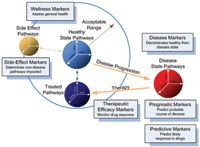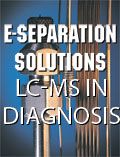Applying LC-MS to Disease and Wellness Diagnosis
LCGC recently spoke with Fred E. Regnier, the John H. Law distinguished professor in the Department of Chemistry at Purdue University (West Lafayette, Indiana) and a member of LCGC's editorial advisory board.
LCGC recently spoke with Fred E. Regnier, the John H. Law distinguished professor in the Department of Chemistry at Purdue University (West Lafayette, Indiana) and a member of LCGC's editorial advisory board. Regnier is known as an innovator and has received 45 patents related to the separation and detection of proteins and peptides. He has also done extensive work in proteomics and is the 2013 recipient of the ACS Award for Separations Science and Technology.
Your recent work in proteomics led to a technology termed mass-linked immunoselective analysis (MALISA), which makes it possible to analyze 50 proteins in 30 min at concentrations as low as 0.1 ng/mL. What do you hope to achieve with this technology in terms of disease-associated biomarkers?
We would like to use MALISA to enable personalized medicine by determining different sets of biomarkers as shown in Figure 1. Subsequent to biomarker discovery it is generally the objective to determine no more than 50–100 specific substances in a single analysis as might be used in personalized medicine. The premise here is that there are multiple sets of biomarkers. Instead of trying to identify all biomarkers at once, you would identify smaller sets as needed to assess "wellness."

Figure 1: A personalized medicine assessment model based on biomarkers found in various biochemical pathways. The health status of an individual in this model would be evaluated by analyzing biomarkers from multiple pathways that assess "wellness," diagnose the onset and progression of a disease, predict the probable course of the disease, suggest therapeutic agents, assess treatment efficacy, and determine the degree to which an individual has returned to an acceptable level of health.
Does more work need to be done with this method to achieve the type of results that could affect disease diagnosis?
Some work has be done on the method itself, but the bulk of the work would be in discovering the different sets of 10–20 markers each that assess disease onset and progression, predict the course of a disease, suggest therapeutic treatment, assess treatment efficacy, and determine recovery.
How can separation scientists help solve problems in biology or clinical diagnostics in a more effective manner?
On the whole we are perhaps too focused on our field alone. Those in our community who have been most successful in addressing biological and clinical problems did so by collaborating with biologists and physicians, along with learning more about the life-science problems they were trying to address.
You have described a vision of "having an LC–MS system in every doctor's office." How do you imagine this would be used? What will it take to achieve that vision?
Actually, my vision is more of every physician having MALISA-type liquid chromatography–mass spectrometry (LC–MS) data available when you visit them. We are simply not extracting a fraction of the data that biological fluid analysis can provide. There is no question that biological fluids tell an enormous amount about what has happened to you and what will happen in the future. We just don't know how to assess those health-related signatures yet.
Another part of my vision is that the analytical instrumentation will eventually determine determine in serial fashion what tests should be run. From an initial, quick analysis your blood sample will be compared with a huge population of individuals of your age, ethnicity, and gender to see how you relate. Based on this analysis, further tests needed to clarify the condition of your health will be obvious. In the end, the physician will still make all calls relating to your health, but we will be able to provide the doctor with so much more information.
After co-founding five companies, what advice would you offer a young scientist looking to follow in your footsteps?
I have noticed that people who are passionate and believe they can personally change the world often do. It isn't so much their passion and beliefs that make them successful as the focus and intensity with which they pursue their dreams. A second suggestion is to have large dreams and think about how you might achieve them. You won't achieve all your dreams, but having a dream and a plan takes you so much further than having none at all.
So far in your career, you have received 45 patents. What is your secret to being so innovative?
I'm not sure. One of my more valuable experiences was to spend six months at a small company early in my career where I traveled around with the sales force. They were always asking people what their problems were and what needed to be solved. Knowing that, I would often see a potential solution back in the academic world. It also tells you something about what to patent. Thinking in terms of identifying central, underlying problems is perhaps the basis to seeing areas where patents are needed.
What do you think is your most important achievement in separations science?
Based on the work of ShungHo Chang, we reduced protein separation times 100-fold through the use of rigid, microparticular support materials. Moreover, we patented and commercialized those packings within a year. It was great for graduate students to see parts of their PhD thesis in the marketplace before they graduated.
The process-scale packing material POROS is another separation material I was associated with of which we are very proud.
What do you still hope to achieve?
Huge numbers of people suffer from oxidative stress diseases. These diseases range from diabetes mellitus, atherosclerosis, neurodegenerative diseases (Alzheimer's disease, Parkinson's disease, and amyotrophic lateral sclerosis) to inflammatory diseases (arthritis and chronic lung disease), cancer, and aging. A common feature of all these diseases is irreversible oxidative modifications of proteins, but the type of oxidation is disease-specific and can be detected by MALISA. Critical to this is that antioxidants protect against oxidative stress. You can quickly determine what one's diet is doing fora person.
During the course of the past decade, we have identified a large number of oxidized protein markers that indicate onset and progression of these diseases along with the degree to which antioxidant foods protect against these diseases.
Although we filed a series of patents on tests related to these diseases, I would like to explore the utility of all our tests more and ultimately bring them to the clinic. The one I am most enthusiastic about is assessing coronary artery disease risk in type II diabetics through a simple blood test. It is probably not surprising that there is a strong separations component in all of our tests. MALISA is the most logical way to do all of these tests.
Extracting Estrogenic Hormones Using Rotating Disk and Modified Clays
April 14th 2025University of Caldas and University of Chile researchers extracted estrogenic hormones from wastewater samples using rotating disk sorption extraction. After extraction, the concentrated analytes were measured using liquid chromatography coupled with photodiode array detection (HPLC-PDA).
Polysorbate Quantification and Degradation Analysis via LC and Charged Aerosol Detection
April 9th 2025Scientists from ThermoFisher Scientific published a review article in the Journal of Chromatography A that provided an overview of HPLC analysis using charged aerosol detection can help with polysorbate quantification.
Removing Double-Stranded RNA Impurities Using Chromatography
April 8th 2025Researchers from Agency for Science, Technology and Research in Singapore recently published a review article exploring how chromatography can be used to remove double-stranded RNA impurities during mRNA therapeutics production.




